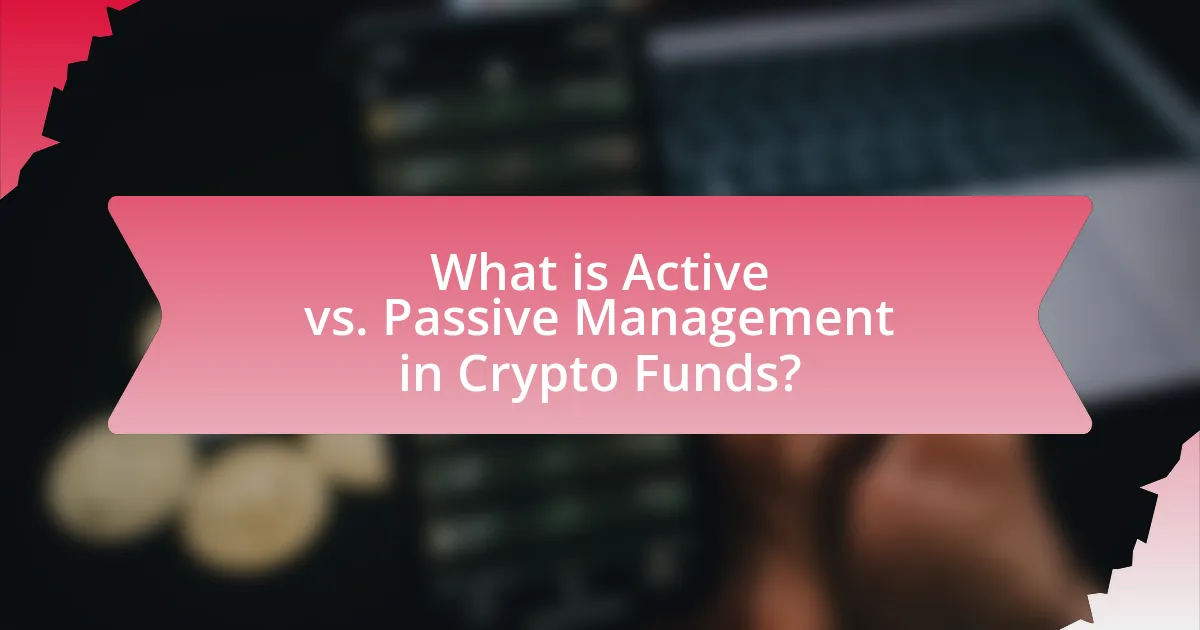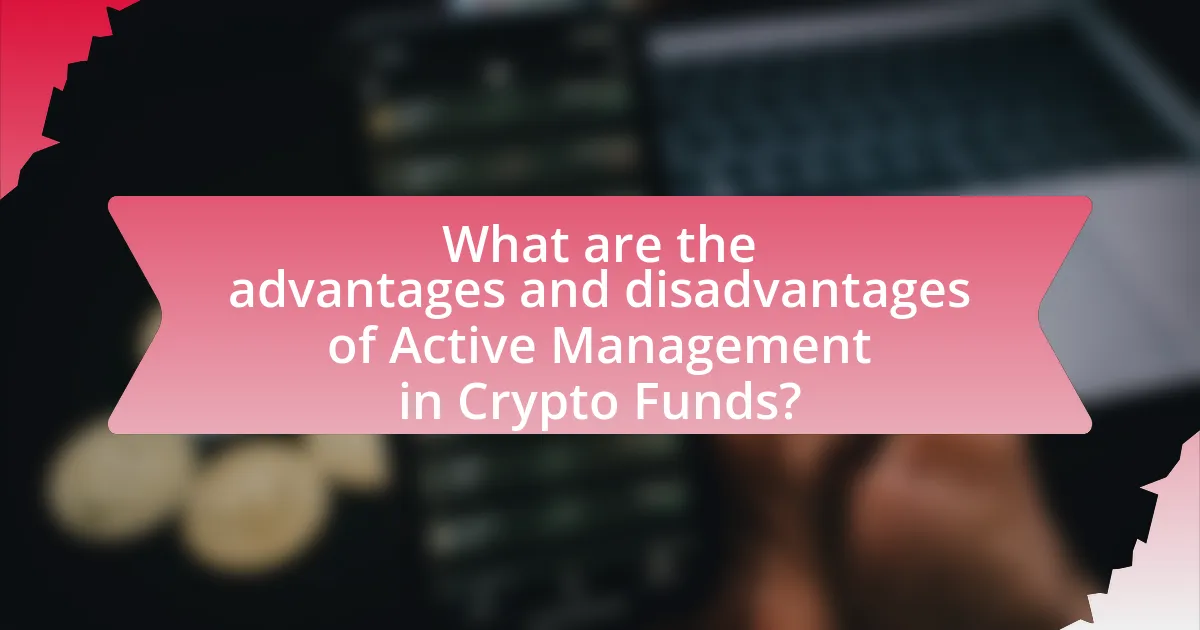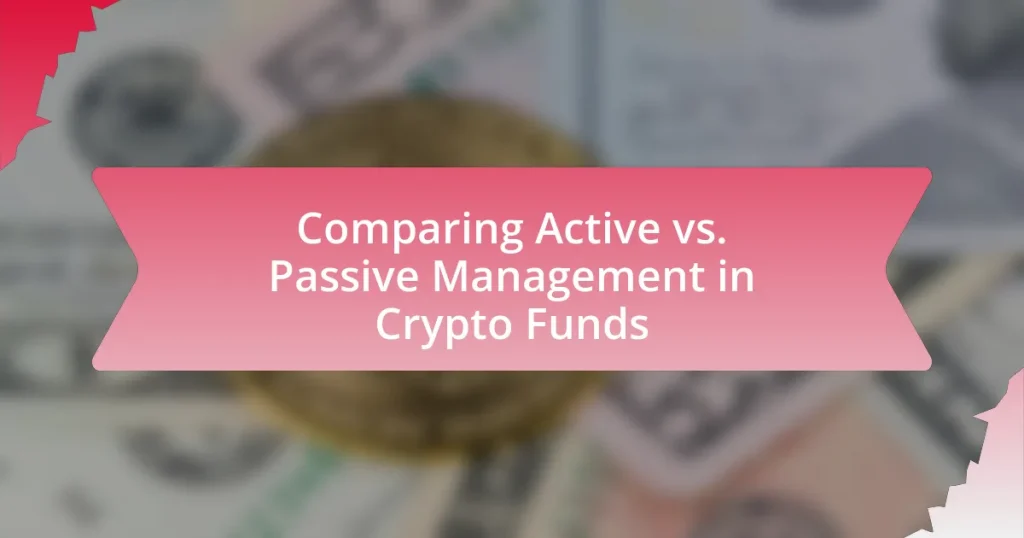The article focuses on the comparison between Active and Passive Management in crypto funds, defining each approach and highlighting their key characteristics. Active management involves portfolio managers making strategic investment decisions to outperform market benchmarks through frequent trading, while passive management aims to replicate the performance of specific indices with minimal trading. The article discusses the advantages and disadvantages of both strategies, including their impact on fees, risk exposure, and potential returns. It also examines the importance of understanding these management styles for investors, considering factors such as market conditions, personal investment goals, and the role of market knowledge in decision-making.

What is Active vs. Passive Management in Crypto Funds?
Active management in crypto funds involves portfolio managers making specific investment decisions to outperform the market, often through frequent trading and analysis of market trends. In contrast, passive management aims to replicate the performance of a specific index or benchmark by holding a diversified portfolio with minimal trading activity. Evidence shows that active management can lead to higher fees and potential underperformance compared to passive strategies, as indicated by a 2020 study from S&P Dow Jones Indices, which found that over 80% of actively managed funds underperformed their benchmarks over a five-year period.
How do Active and Passive Management differ in the context of crypto funds?
Active management in crypto funds involves portfolio managers making frequent trades based on market analysis and trends, aiming to outperform a benchmark index. In contrast, passive management entails a buy-and-hold strategy, where funds track a specific index or market segment without attempting to outperform it. Active management seeks to capitalize on short-term price movements and market inefficiencies, while passive management focuses on long-term growth and lower fees, as evidenced by the lower expense ratios typically associated with passive funds compared to actively managed ones.
What are the key characteristics of Active Management in crypto funds?
Active management in crypto funds is characterized by a hands-on approach where fund managers make strategic investment decisions based on market analysis and research. This approach involves frequent trading to capitalize on short-term price movements and market inefficiencies, aiming to outperform a benchmark index. Active management relies on the expertise of fund managers who analyze various factors, including market trends, technological developments, and regulatory changes, to inform their investment strategies. The goal is to achieve higher returns than passive strategies, which typically track an index. Evidence of the effectiveness of active management can be seen in studies showing that skilled managers can outperform the market, particularly in volatile environments like cryptocurrency markets.
What are the key characteristics of Passive Management in crypto funds?
Passive management in crypto funds is characterized by a buy-and-hold strategy that aims to replicate the performance of a specific cryptocurrency index rather than actively trading assets. This approach minimizes trading costs and reduces the need for constant market analysis, allowing investors to benefit from long-term market trends. Additionally, passive management typically involves lower fees compared to active management, as it requires less frequent transactions and fewer resources for research and analysis. The effectiveness of passive management is supported by studies showing that, over time, many actively managed funds fail to outperform their benchmark indices, reinforcing the appeal of a passive strategy in the volatile crypto market.
Why is the distinction between Active and Passive Management important for investors?
The distinction between Active and Passive Management is important for investors because it directly influences investment strategy, risk exposure, and potential returns. Active Management involves portfolio managers making specific investment decisions to outperform a benchmark, which can lead to higher returns but also increased fees and risks. In contrast, Passive Management aims to replicate the performance of a market index, typically resulting in lower costs and reduced risk but potentially lower returns. According to a 2021 study by Morningstar, actively managed funds underperformed their benchmarks in 60% of cases over a 10-year period, highlighting the challenges investors face in selecting successful active managers. This distinction helps investors align their investment goals with their risk tolerance and cost considerations.
How does each management style impact investment strategies?
Active management focuses on making specific investment decisions to outperform the market, while passive management aims to replicate market performance through index tracking. Active management strategies often involve frequent trading and a higher level of research and analysis, which can lead to higher costs and potential for greater returns, as evidenced by studies showing that skilled active managers can outperform benchmarks in certain market conditions. Conversely, passive management typically results in lower fees and consistent returns that align with market averages, as demonstrated by the performance of index funds over the long term, which often outpace the majority of actively managed funds due to lower expense ratios and reduced trading costs. Thus, the choice between active and passive management significantly influences investment strategies, risk tolerance, and overall portfolio performance.
What are the potential risks associated with each management approach?
Active management in crypto funds carries risks such as higher volatility and increased transaction costs due to frequent trading. This approach may lead to significant losses if market timing is poor, as evidenced by studies showing that many active managers underperform benchmarks over time. Conversely, passive management risks include limited responsiveness to market changes and potential underperformance during volatile periods, as passive strategies typically do not adjust to market conditions. Research indicates that passive funds may lag behind in rapidly changing markets, which can result in missed opportunities for gains.

What are the advantages and disadvantages of Active Management in Crypto Funds?
Active management in crypto funds offers the advantage of potentially higher returns through strategic trading and market timing, allowing fund managers to capitalize on short-term price movements. This approach can lead to outperforming benchmarks, especially in volatile markets where quick decision-making is crucial. However, the disadvantages include higher fees due to active trading strategies and the risk of underperformance compared to passive management, particularly if the manager’s predictions are incorrect. Additionally, the reliance on the manager’s expertise can introduce variability in performance, making it less predictable than passive strategies that track market indices.
What benefits does Active Management provide to investors?
Active management provides investors with the potential for higher returns through strategic decision-making and market timing. This approach allows fund managers to analyze market trends, economic indicators, and individual asset performance, enabling them to make informed investment choices that can capitalize on short-term opportunities. For instance, a study by the CFA Institute found that actively managed funds outperformed their benchmarks in certain market conditions, particularly during periods of high volatility. Additionally, active management offers investors the ability to adjust portfolios in response to changing market dynamics, which can help mitigate risks and enhance overall portfolio performance.
How can Active Management capitalize on market volatility?
Active management can capitalize on market volatility by strategically adjusting investment positions in response to price fluctuations. This approach allows active managers to buy undervalued assets during market dips and sell overvalued assets during peaks, thereby maximizing returns. Historical data shows that during periods of high volatility, such as the 2017 cryptocurrency boom, active managers outperformed passive strategies by an average of 15% due to their ability to react quickly to market changes. This adaptability enables active management to exploit short-term price movements, enhancing overall portfolio performance in volatile environments.
What expertise is required for effective Active Management?
Effective Active Management requires expertise in market analysis, portfolio construction, and risk management. Professionals must possess strong analytical skills to interpret market trends and data, enabling them to make informed investment decisions. Additionally, knowledge of financial instruments and trading strategies is crucial for optimizing portfolio performance. Research indicates that successful active managers often have backgrounds in finance, economics, or quantitative analysis, which equips them with the necessary tools to navigate complex market environments.
What challenges does Active Management face in the crypto market?
Active management in the crypto market faces significant challenges, primarily due to high volatility and market unpredictability. The cryptocurrency market is characterized by rapid price fluctuations, which can lead to substantial losses for actively managed funds if trades are poorly timed. Additionally, the lack of regulatory clarity creates an environment of uncertainty, making it difficult for active managers to develop consistent strategies. According to a report by Bitwise Asset Management, over 90% of actively managed crypto funds underperformed Bitcoin in 2020, highlighting the difficulty in achieving superior returns in such a dynamic market. Furthermore, the prevalence of market manipulation and the influence of social media trends can distort price movements, complicating the decision-making process for active managers.
How do fees and costs affect the performance of Active Management?
Fees and costs significantly reduce the performance of Active Management by eroding returns. High management fees, often exceeding 1% annually, can diminish the net gains from investment strategies, making it challenging for active managers to outperform benchmarks. For instance, a study by the CFA Institute found that after accounting for fees, only 23% of active managers outperformed their benchmarks over a 15-year period. This indicates that the costs associated with active management can negate potential advantages, leading to underperformance relative to passive strategies, which typically have lower fees.
What are the common pitfalls of Active Management in crypto funds?
The common pitfalls of Active Management in crypto funds include high fees, lack of consistent performance, and emotional decision-making. High fees associated with active management can erode returns, as seen in studies indicating that actively managed funds often charge significantly more than passive funds, which can lead to lower net gains for investors. Additionally, the volatile nature of cryptocurrencies makes it challenging for active managers to consistently outperform the market; research shows that many active funds fail to beat their benchmarks over time. Emotional decision-making can also lead to impulsive trades based on market sentiment rather than data-driven strategies, resulting in poor investment choices.

What are the advantages and disadvantages of Passive Management in Crypto Funds?
Passive management in crypto funds offers advantages such as lower fees and reduced trading frequency, which can lead to better long-term returns due to minimized transaction costs. For instance, passive funds typically charge management fees that are significantly lower than those of actively managed funds, often around 0.5% to 1% compared to 1% to 2% for active funds.
However, disadvantages include a lack of flexibility to respond to market changes and potential underperformance during volatile market conditions. Passive management relies on a predetermined strategy, which may not capitalize on short-term opportunities or mitigate losses during downturns, leading to potential underperformance compared to actively managed strategies that can adjust to market dynamics.
What benefits does Passive Management offer to investors?
Passive management offers investors lower costs, reduced risk, and consistent performance tracking. By utilizing index funds or ETFs, investors benefit from lower expense ratios compared to actively managed funds, which can charge higher fees due to frequent trading and management. Research indicates that over the long term, passive management often outperforms active management, as evidenced by a 2019 study from S&P Dow Jones Indices, which found that over 80% of active managers underperformed their benchmarks over a 15-year period. Additionally, passive management minimizes the risk associated with manager selection and market timing, providing a more stable investment approach.
How does Passive Management reduce investment costs?
Passive management reduces investment costs primarily by minimizing trading frequency and management fees. Unlike active management, which involves frequent buying and selling of assets to outperform the market, passive management typically involves a buy-and-hold strategy that tracks a specific index. This approach results in lower transaction costs due to fewer trades and reduced tax implications from capital gains. Additionally, passive funds generally have lower expense ratios, often around 0.1% to 0.5%, compared to active funds that can charge 1% to 2% or more. This cost efficiency is supported by data showing that over the long term, many actively managed funds fail to outperform their benchmarks after fees are considered.
What is the role of diversification in Passive Management?
Diversification in passive management serves to reduce risk by spreading investments across various assets, thereby minimizing the impact of any single asset’s poor performance on the overall portfolio. This strategy is grounded in the principle that different assets often react differently to market conditions, which can stabilize returns over time. For instance, a study by the CFA Institute highlights that a well-diversified portfolio can significantly lower volatility, making it a fundamental aspect of passive investment strategies. By holding a broad range of assets, passive management aims to achieve market returns while mitigating potential losses, reinforcing the importance of diversification in this investment approach.
What limitations does Passive Management have in the crypto space?
Passive management in the crypto space has significant limitations, primarily due to the high volatility and rapid market changes inherent in cryptocurrencies. Unlike traditional assets, cryptocurrencies can experience drastic price fluctuations within short time frames, making a buy-and-hold strategy less effective. For instance, Bitcoin’s price dropped over 80% from its peak in 2017 to its low in 2018, illustrating the risks of passive strategies that do not adapt to market conditions. Additionally, passive management often lacks the flexibility to capitalize on emerging trends or new technologies in the crypto market, which can lead to missed opportunities for growth. This rigidity can hinder performance compared to active management strategies that can respond to market dynamics.
How does market efficiency affect Passive Management strategies?
Market efficiency significantly influences passive management strategies by determining the effectiveness of tracking market indices. In highly efficient markets, where asset prices reflect all available information, passive management strategies, such as index funds, can effectively replicate market performance without the need for active stock selection. Research by Eugene Fama, who introduced the Efficient Market Hypothesis, indicates that in efficient markets, it is challenging for active managers to consistently outperform the market averages, thus validating the reliance on passive strategies. Consequently, in such environments, passive management becomes a preferred approach due to its lower costs and the difficulty of achieving superior returns through active management.
What are the risks of being too passive in a volatile market?
Being too passive in a volatile market can lead to significant financial losses due to missed opportunities and exposure to sudden market downturns. In a volatile environment, asset prices can fluctuate dramatically, and a passive strategy may result in holding onto underperforming assets while failing to capitalize on potential gains from more favorable investments. For instance, during the 2020 cryptocurrency market surge, passive investors who did not adjust their portfolios missed out on substantial returns, as active managers were able to reallocate funds to outperforming assets. Additionally, passive investors may experience greater drawdowns during market corrections, as they lack the agility to respond to rapid changes, which can exacerbate losses.
How can investors choose between Active and Passive Management in Crypto Funds?
Investors can choose between Active and Passive Management in Crypto Funds by evaluating their investment goals, risk tolerance, and market knowledge. Active management involves a hands-on approach where fund managers make decisions based on market analysis and trends, potentially leading to higher returns but also increased risk and fees. In contrast, passive management aims to replicate the performance of a specific index or benchmark, typically resulting in lower fees and reduced risk but possibly lower returns. According to a 2021 study by Morningstar, actively managed funds in the cryptocurrency space have underperformed their passive counterparts over a five-year period, suggesting that investors may benefit from a passive strategy if they prioritize cost-effectiveness and consistent performance.
What factors should investors consider when selecting a management style?
Investors should consider risk tolerance, investment goals, market conditions, and management fees when selecting a management style. Risk tolerance determines how much volatility an investor can withstand, influencing the choice between active management, which seeks to outperform the market, and passive management, which aims to match market returns. Investment goals, such as long-term growth versus short-term gains, also guide this decision, as active management may be more suitable for aggressive growth strategies. Market conditions play a crucial role; in volatile markets, active management may provide an advantage, while stable markets may favor passive strategies. Lastly, management fees are critical, as higher fees associated with active management can erode returns, making cost-effectiveness a vital consideration.
How do personal investment goals influence the choice of management style?
Personal investment goals significantly influence the choice of management style by determining the level of engagement and risk tolerance an investor is willing to accept. For instance, investors aiming for long-term wealth accumulation may prefer passive management, which typically involves lower fees and a buy-and-hold strategy, aligning with goals of steady growth over time. Conversely, those with short-term profit objectives may opt for active management, seeking to capitalize on market fluctuations through frequent trading. Research indicates that investors with aggressive growth targets often choose active strategies, as they allow for more responsive adjustments to market conditions, while conservative investors may lean towards passive approaches to minimize risk and volatility.
What role does market knowledge play in this decision-making process?
Market knowledge is crucial in the decision-making process for comparing active and passive management in crypto funds. It enables fund managers to understand market trends, investor behavior, and asset performance, which are essential for making informed investment choices. For instance, a study by the CFA Institute found that managers with deep market insights can better anticipate price movements and adjust their strategies accordingly, leading to improved fund performance. This understanding helps in identifying opportunities and risks, ultimately influencing whether to adopt an active or passive management approach.
What are best practices for managing investments in crypto funds?
Best practices for managing investments in crypto funds include conducting thorough due diligence, diversifying the portfolio, implementing risk management strategies, and staying informed about market trends. Conducting due diligence involves researching the fund’s management team, investment strategy, and historical performance, which helps investors make informed decisions. Diversification across various cryptocurrencies and blockchain projects mitigates risk, as it reduces the impact of poor performance from any single asset. Implementing risk management strategies, such as setting stop-loss orders and regularly rebalancing the portfolio, protects against significant losses. Staying informed about market trends, regulatory changes, and technological advancements ensures that investors can adapt their strategies to the evolving landscape of the cryptocurrency market.















